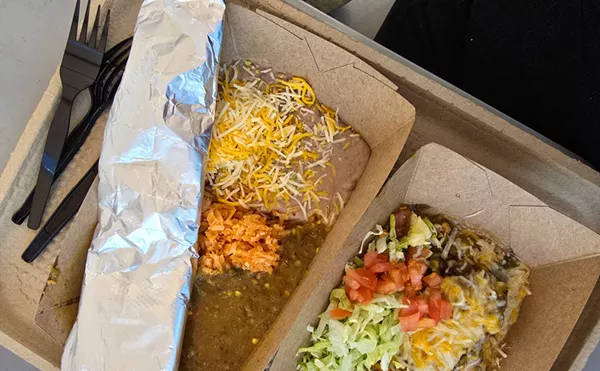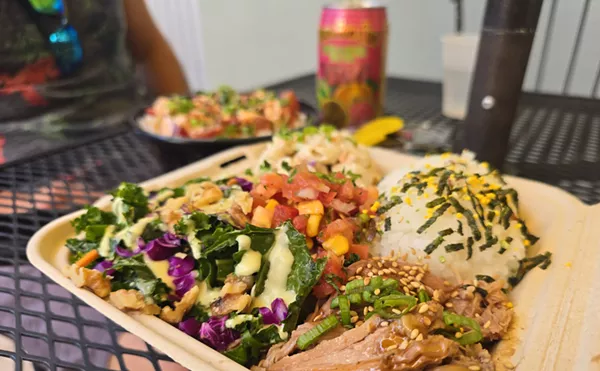Roll down your window on Santa Fe Drive or Federal Boulevard these days and you’ll smell the smoky, sweet Colorado perfume of chiles roasting. The season is here: Get your flame-fired chiles now, before they're gone.
“There is a shortage of chile this year,” roastedchili.com veteran Scott Young says as he roasts my chiles. “We'll be open until Halloween, but we could run out sooner.”
Fiery breath erupts erratically from the roaster, roaring over the noise of passing cars. Flames lick the chiles and they tumble like lucky lottery balls. In a few minutes, my gems are charred onyx, bubbling and crackling as Scott slides them off the roaster, careful not leave behind any stragglers.
“Every chile counts when you want them in January,” Scott says, smiling as he scoops ten pounds into a plastic bag, where the chiles will sweat for three hours so that the skins peel easily.
Roastedchili.com's main location specializes in Hatch and Pueblo chiles – like the Mosco, which has grown in popularity so much that the demand outweighs supply. Colorado State University horticulturist Michael Bartolo developed the Mosco pepper in 2005.
My burning lips will tell you: This Pueblo pepper packs a fiery punch. Bartolo credits the Mosco's unique heat plus sweet flavor to southeastern Colorado's sunny days and cool nights. The Mosco "uses the best horticultural traits and the heritage of the Mira Sol pepper, whose seeds growers had saved for generations,” says Bartolo. Known for its mature red color and superior roasting quality, the Mosco chile’s sweet, tangy heat is addicting.
"We have people come here and buy twenty baskets at a time,” says owner Peter Elliot Jr., a second-generation chile seller.
Jesus Gonzalez stops by especially for Moscos and ships half to his nephew in Chicago two to three times a season. “We are from Puerto Rico, and I will put Moscos in chicken, beef, chile, soup or just one in my mother’s arroz con gandules — rice with pigeon peas,” he says.
Chile roasting is a competitive but unregulated business in Denver. “Five years ago, there wasn’t half as many stands as there are now,” says Marilyn Manchego, who owns A Taste of Questa.
The City and County of Denver does not conduct regular inspections for roasting and retailing vendors. "We consider it low-risk and address it only on a complaint basis," says Danica Lee, director of the Public Health Inspections division of the Denver Department of Environmental Health.
Seasoned vendors have stories of scams that take advantage of uninformed consumers. Since so many chiles taste similar, it can be hard to tell if you're being misguided. “The chile-pepper industry is a rough one,” warns Elliot. “The consumer is at the mercy of trusting you.”
“There is definitely a dark side to the chile business,” adds Phil Sedillo of Taste of Chile, who has been in the business for thirty years.
Anita Edge started denvergreenchili.com in 2006 as a directory to help consumers locate seasonal chile stands. The most common complaint she hears are vendors short-changing customers on the amount of chile in a "bushel." Beware of bogus pricing, too, she warns: Edge has stopped by stands to ask about prices, only to be told, "What are Joe's prices down the street? That's how much we charge."
And above all, only buy fresh roasted Pueblo and Hatch chiles between August and the end of October, when they're in season. Any other time, it's a scam.
“[People] are selling a chile out of Mexico with thin skin that cost them like $10 a bag and they're calling it Hatch,” warns Young. “They're even going around and stealing Hatch bags out of our dumpsters.”
Above all, smart buyers know that the number-one question to ask right now is this: “How long are you selling chiles?” With the season ending in late October, roastedchili.com texts a countdown-to-closing message to loyalists. Prices can change daily based on supply and demand.
How can you up your chile game? Keep reading for some tips.
CHILE BUYING TIPS
1. Be your own health inspector.
Cleanliness counts. Chiles should be kept off the ground, and roasting machines should be swept between batches.
2. Ask questions.
Questions like these: What varieties are in your mild, medium or hot batches? How often do you get fresh shipments? What farms do you get chiles from? How are they stored? (Warehouse or truck refrigeration is ideal. )
3. Examine chiles before roasting.
Look for farm names on bags. Chiles should have smooth skin, not soft or wrinkled. Taste the raw chile: It should be crisp and cool to the touch.
4. Make sure the chile you pick is the one that’s roasted.
Beware of roasters swapping chiles.
5. Be wary of pre-roasted bags or flash sales.
They could contain reject chiles.
ROASTING AND PREPARATION TIPS
1. After roasting, chiles should be meaty and fully intact, not a soupy mess.
2. The vendor should use a special plastic chile-roasting bag. Your chiles should sweat for a maximum of three to four hours so that the skin can peel easily.
3. Use gloves when you're peeling. The skin should come off easily in one motion, then remove top and seeds.
4. Don’t run under water. Chiles will lose flavor.
5. Freeze chiles in vacuum-seal bags or freezer bags to preserve freshness.
Get 'em now, before the chiles are gone, so that you can enjoy them all winter. And on your way home from your successful shopping mission, take a deep breath of roasted chile: the best Colorado fall flavor and car air freshener.

Audio By Carbonatix
[
{
"name": "GPT - Billboard - Slot Inline - Content - Labeled - No Desktop",
"component": "23668565",
"insertPoint": "2",
"requiredCountToDisplay": "2"
},{
"name": "STN Player - Float - Mobile Only ",
"component": "23853568",
"insertPoint": "2",
"requiredCountToDisplay": "2"
},{
"name": "Editor Picks",
"component": "17242653",
"insertPoint": "4",
"requiredCountToDisplay": "1"
},{
"name": "Inline Links",
"component": "18838239",
"insertPoint": "8th",
"startingPoint": 8,
"requiredCountToDisplay": "7",
"maxInsertions": 25
},{
"name": "GPT - 2x Rectangles Desktop, Tower on Mobile - Labeled",
"component": "24956856",
"insertPoint": "8th",
"startingPoint": 8,
"requiredCountToDisplay": "7",
"maxInsertions": 25
},{
"name": "Inline Links",
"component": "18838239",
"insertPoint": "8th",
"startingPoint": 12,
"requiredCountToDisplay": "11",
"maxInsertions": 25
},{
"name": "GPT - Leaderboard to Tower - Slot Auto-select - Labeled",
"component": "17676724",
"insertPoint": "8th",
"startingPoint": 12,
"requiredCountToDisplay": "11",
"maxInsertions": 25
}
]










